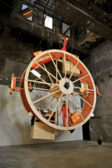ARTICLES
Wild Turkey Bourbon Visitor Center
Taken with the Spirits: As it courts a new clientele, the Wild Turkey distillery opens a visitor center by De Leon & Primmer Architecture Workshop that pays homage to the landscape that gave birth to bourbon.
Read More
21c Museum Hotels by Deborah Berke Partners
Bentonville, Arkansas; Cincinnati, Ohio; and Louisville, Kentucky
Read More
Copyright ©2024. All Rights Reserved BNP Media.
Design, CMS, Hosting & Web Development :: ePublishing

